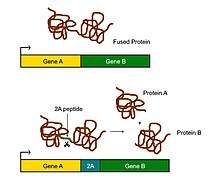2A self-cleaving peptides
2A self-cleaving peptides, or 2A peptides, is a class of 18–22 aa-long peptides, which can induce the cleaving of the recombinant protein in a cell.[1][2] These peptides share a core sequence motif of DxExNPGP, and are found in a wide range of viral families. They help break apart polyproteins by causing the ribosome to fail at making a peptide bond.[3][4]

The members of 2A peptides are named after the virus in which they have been first described. For example, F2A, the first described 2A peptide, is derived from foot-and-mouth disease virus. The name "2A" itself comes from the gene numbering scheme of this virus.[1][5]
Members
Four members of 2A peptides family are frequently used in life science research. They are P2A, E2A, F2A and T2A. F2A is derived from foot-and-mouth disease virus 18; E2A is derived from equine rhinitis A virus; P2A is derived from porcine teschovirus-1 2A; T2A is derived from thosea asigna virus 2A.[1]
The following table shows the sequences of four members of 2A peptides. Adding the optional linker “GSG” (Gly-Ser-Gly) on the N-terminal of a 2A peptide helps with efficiency.[6]
| Name | Sequence |
|---|---|
| T2A | (GSG) EGRGSLL TCGDVEENPGP |
| P2A | (GSG) ATNFSLLKQAGDVEENPGP |
| E2A | (GSG) QCTNYALLKLAGDVESNPGP |
| F2A | (GSG) VKQTLNFDLLKLAGDVESNPGP |
Description
The cleavage is trigged by breaking of peptide bond between the Proline (P) and Glycine (G) in C-terminal of 2A peptide. The exact molecular mechanism of 2A-peptide-mediated cleavage is still unknown.[7][8] However, it is believed to involve ribosomal "skipping" of glycyl-prolyl peptide bond formation rather than true proteolytic cleavage.[9][10]
Application
In genetic engineering, the 2A peptides are used to cleave a longer peptide into two shorter peptides. The 2A peptides can be applied when the fused protein doesn’t work. Inserting the CDS of a 2A peptide into the fusing point or replacing the linker sequence with the CDS of a 2A peptide protein can cleave the fused protein into two separated peptides, making the two peptides to regain the function.[6]
2A peptides, when combined with the IRES elements, can make it possible to generate four separated peptides within a single transcript.[1]
Incomplete cleavage
Different 2A peptides have different efficiencies of self-cleaving, P2A being the most and F2A the least efficient.[11] Therefore, up to 50% of F2A-linked proteins can remain in the cell as a fusion protein, which might cause some unpredictable outcomes, including a gain of function.[12]
See also
References
- Liu, Ziqing; Chen, Olivia; Wall, J. Blake Joseph; Zheng, Michael; Zhou, Yang; Wang, Li; Ruth Vaseghi, Haley; Qian, Li; Liu, Jiandong (2017). "Systematic comparison of 2A peptides for cloning multi-genes in a polycistronic vector". Scientific Reports. 7 (1): 2193. Bibcode:2017NatSR...7.2193L. doi:10.1038/s41598-017-02460-2. ISSN 2045-2322. PMC 5438344. PMID 28526819.
- Sampath Karuna; Roy Sudipto (30 August 2010). Live Imaging In Zebrafish: Insights Into Development And Disease. World Scientific. pp. 51–52. ISBN 978-981-4464-89-5.
- Luke, Garry A.; de Felipe, Pablo; Lukashev, Alexander; Kallioinen, Susanna E.; Bruno, Elizabeth A.; Ryan, Martin D. (1 April 2008). "Occurrence, function and evolutionary origins of '2A-like' sequences in virus genomes". Journal of General Virology. 89 (4): 1036–1042. doi:10.1099/vir.0.83428-0. PMC 2885027. PMID 18343847.
- Yang, X; Cheng, A; Wang, M; Jia, R; Sun, K; Pan, K; Yang, Q; Wu, Y; Zhu, D; Chen, S; Liu, M; Zhao, XX; Chen, X (2017). "Structures and Corresponding Functions of Five Types of Picornaviral 2A Proteins". Frontiers in Microbiology. 8: 1373. doi:10.3389/fmicb.2017.01373. PMC 5519566. PMID 28785248.
- Ryan, MD; King, AM; Thomas, GP (November 1991). "Cleavage of foot-and-mouth disease virus polyprotein is mediated by residues located within a 19 amino acid sequence". The Journal of General Virology. 72 ( Pt 11) (11): 2727–32. doi:10.1099/0022-1317-72-11-2727. PMID 1658199.
- Szymczak-Workman, A. L.; Vignali, K. M.; Vignali, D. A. A. (2012). "Design and Construction of 2A Peptide-Linked Multicistronic Vectors". Cold Spring Harbor Protocols. 2012 (2): 199–204. doi:10.1101/pdb.ip067876. ISSN 1559-6095. PMID 22301656.
- Wang, Yuancheng; Wang, Feng; Wang, Riyuan; Zhao, Ping; Xia, Qingyou (2015). "2A self-cleaving peptide-based multi-gene expression system in the silkworm Bombyx mori". Scientific Reports. 5 (1): 16273. Bibcode:2015NatSR...516273W. doi:10.1038/srep16273. ISSN 2045-2322. PMC 4633692. PMID 26537835.
- "Cleavage Activity of Aphtho- and Cardiovirus 2A Oligopeptidic Sequences". University of St Andrews. Archived from the original on 2016-12-30. Retrieved 2019-01-05.
- Ryan, Martin D.; Mehrotra, Amit; Gani, David; Donnelly, Michelle L. L.; Hughes, Lorraine E.; Luke, Garry; Li, Xuejun (1 May 2001). "Analysis of the aphthovirus 2A/2B polyprotein 'cleavage' mechanism indicates not a proteolytic reaction, but a novel translational effect: a putative ribosomal 'skip'". Journal of General Virology. 82 (5): 1013–1025. doi:10.1099/0022-1317-82-5-1013. PMID 11297676.
- Sharma, Pamila; Yan, Fu; Doronina, Victoria A.; Escuin-Ordinas, Helena; Ryan, Martin D.; Brown, Jeremy D. (April 2012). "2A peptides provide distinct solutions to driving stop-carry on translational recoding". Nucleic Acids Research. 40 (7): 3143–3151. doi:10.1093/nar/gkr1176. PMC 3326317. PMID 22140113.
- Kim, Jin Hee; Lee, Sang-Rok; Li, Li-Hua; Park, Hye-Jeong; Park, Jeong-Hoh; Lee, Kwang Youl; Kim, Myeong-Kyu; Shin, Boo Ahn; Choi, Seok-Yong (2011-04-29). Thiel, Volker (ed.). "High Cleavage Efficiency of a 2A Peptide Derived from Porcine Teschovirus-1 in Human Cell Lines, Zebrafish and Mice". PLOS ONE. 6 (4): e18556. Bibcode:2011PLoSO...618556K. doi:10.1371/journal.pone.0018556. ISSN 1932-6203. PMC 3084703. PMID 21602908.
- Velychko, Sergiy; Kang, Kyuree; Kim, Sung Min; Kwak, Tae Hwan; Kim, Kee-Pyo; Park, Chanhyeok; Hong, Kwonho; Chung, ChiHye; Hyun, Jung Keun (April 2019). "Fusion of Reprogramming Factors Alters the Trajectory of Somatic Lineage Conversion". Cell Reports. 27 (1): 30–39.e4. doi:10.1016/j.celrep.2019.03.023. PMID 30943410.